
2004 Perseid Meteor Shower |
(Download a higher resolution picture by clicking on any picture below.)
I drove up to the crest of the Santa Ynez Mountains above Santa Barbara at 3:00 in the morning on Thursday, August 12 to photograph the Perseid meteors. The pictures that I got are typical of the meteor pictures that I have taken before. They're not very spectacular.
I passed several cars coming down from the mountains, people who had already had enough meteor watching for the night.
The night was very warm. Crickets were chirping in the chaparral all around me.
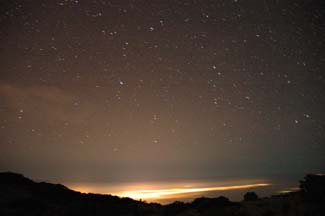 The lights of Santa Barbara can be seen glowing under the marine layer in this
110-second exposure.
The lights of Santa Barbara can be seen glowing under the marine layer in this
110-second exposure.
I put the digital camera on the tripod, set the focal length to 18mm, pointed it at the Milky Way near Cassiopia, and opened the shutter.
 I caught this Perseid meteor near theta-Perseii on the border of the constellations of Perseus and
Andromeda in a 230-second time exposure with an effective film
speed of 400 ISO.
I caught this Perseid meteor near theta-Perseii on the border of the constellations of Perseus and
Andromeda in a 230-second time exposure with an effective film
speed of 400 ISO.
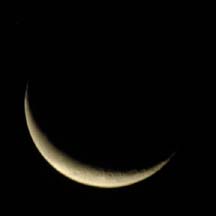 I put the 2x teleconverter
on the 400mm f3.5 telephoto and mounted them on the camera to
shoot this 1/2-second exposure of the waning crescent Moon.
I put the 2x teleconverter
on the 400mm f3.5 telephoto and mounted them on the camera to
shoot this 1/2-second exposure of the waning crescent Moon.
 The exposure above was part of a month long study of
the Moon.
The exposure above was part of a month long study of
the Moon.
 I made a 2-second exposure at 1600 ISO to show the dark side of the moon illuminated by
reflected earthlight.
I made a 2-second exposure at 1600 ISO to show the dark side of the moon illuminated by
reflected earthlight.
I counted 65 Perseids and 2 erratics between 3:30 and 5:10, for a Zenithal Hourly Rate of roughly 40.
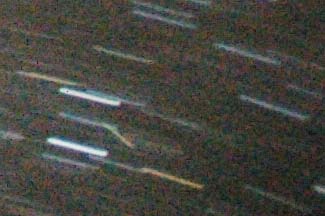 This meteor on the border of the constellations of Camelopardalis and Cassiopia
was caught during a 485-second exposure at 1600 ISO.
This meteor on the border of the constellations of Camelopardalis and Cassiopia
was caught during a 485-second exposure at 1600 ISO.
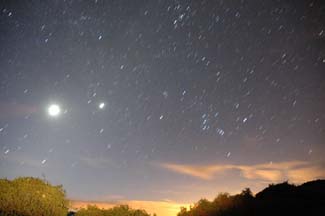 The crescent Moon and Venus were rising in the northeast. Orion was rising just
to the right of them in this 202-second exposure.
The crescent Moon and Venus were rising in the northeast. Orion was rising just
to the right of them in this 202-second exposure.
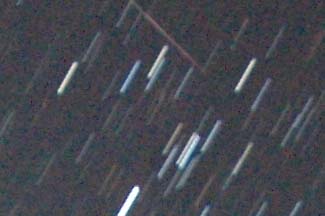 This Perseid meteor streaking across the constellation of Taurus is at the
very top of the frame above.
This Perseid meteor streaking across the constellation of Taurus is at the
very top of the frame above.
The fortieth meteor of the night was a spectacular erratic that came in from the south, across 30 degrees of sky in about two to three seconds. It was quite bright but did not leave a luminous trail.
The sixty-second meteor of the night was a Perseid fireball near the Moon and Venus. Its streak broadened as it flared brightly. It left a luminous trail that was visible for five to ten seconds afterward.
I did not catch an image of either of the brightest meteors.
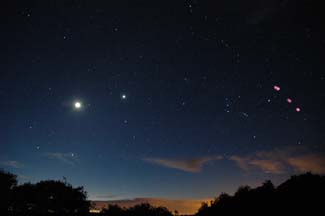 The eastern horizon started to light up by 5:10 A.M in this 22-second exposure.
Can anyone identify the four
small pink spots in this image? They show up in many of the long time exposures I have
made with the digital camera.
The eastern horizon started to light up by 5:10 A.M in this 22-second exposure.
Can anyone identify the four
small pink spots in this image? They show up in many of the long time exposures I have
made with the digital camera.
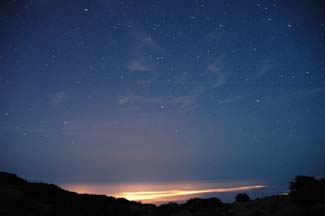 The sky over Santa Barbara started to turn blue in this 86-second exposure.
The sky over Santa Barbara started to turn blue in this 86-second exposure.
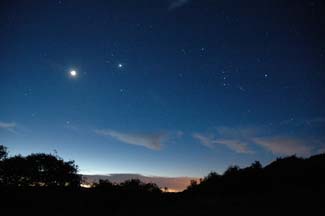 The disappearing stars in this 15-second exposure signaled that sky was getting too bright
to continue shooting time exposures.
The disappearing stars in this 15-second exposure signaled that sky was getting too bright
to continue shooting time exposures.
Send a message to Brian.